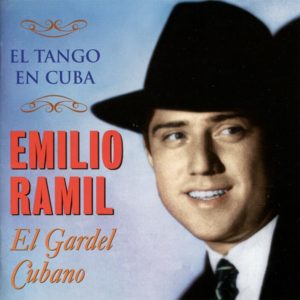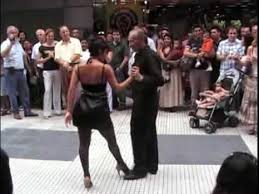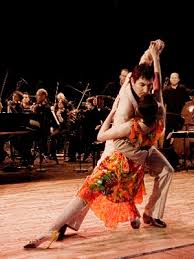 EL “TANGO” ARGENTINO NO HA PERDIDO SU VIGENCIA EN CUBA. FOTOS.
EL “TANGO” ARGENTINO NO HA PERDIDO SU VIGENCIA EN CUBA. FOTOS.
La historia del tango, la música rioplatense en Cuba, la mayor de Las Antillas, data de los primeros años del siglo XX, pero su auge comenzó en el año 1940 con una impresionante relación de artistas argentinos que visitaban regularmente la isla, contribuyendo a la popularidad del género en épocas siguientes.
Bajo la influencia de los tangos, valses y milongas, llegados de allende los mares, surgieron en Cuba innumerables figuras de excelente calidad, entre las que no pueden dejar de mencionarse a Berta Pernas, Zenia Marabal y Emilio Ramil, este último conocido como El Gardel cubano, quien no solo poseía una voz que asemejaba la del Morocho del Abasto, sino que además se le parecía físicamente.
Ese émulo de Gardel traspuso con su arte las fronteras antillanas al actuar en radioemisoras de Montevideo y Buenos Aires, las dos plazas más fuertes del tango. Ramil fue, además, presidente del Tango Club de La Habana en 1953.
Ni el maestro Adolfo Guzmán, extraordinario pianista y compositor, pudo sustraerse al embrujo de la música del Río La Plata; con su orquesta respaldó a muchas figuras que cultivaron esos géneros, y él mismo compuso dos tangos: Lamento árabe (1941) y Caravana (1943).
Surgieron en Cuba varias instituciones de muy diversa índole, pero cuyos perfiles se entrelazan con esa elegante música. Entre ellas: el Tango Club de Cuba, el cabaret La Pampa, el Rincón del Tango del Hotel Bruzón, la Casa del Tango Edmundo Daubar; todas estas en La Habana y en la provincia de Las Villas el cine Gardel, además de muchas peñas y otras formas de reverenciar al sensual ritmo.
Memorable es también la participación de los medios de difusión, como la radio Cadena Roja, escenario del debut de Emilio Ramil, ya mencionado. Y qué decir de la emisora la COCO, que aún mantiene en el aire el gustado programa Oh, Gardel, tango, al que la mayoría, por una simple contracción lingüística conoce como Hogar del Tango.
Este espacio surgió en 1963 con el nombre de Melodías del Plata, popularizado por Antonio García, el mayor divulgador que ha tenido la música argentina en Cuba. En 1980 pasó a dirigirlo por la también locutora y periodista estelar María Luisa Mac Beath, quien a solicitud del director de la COCO, Guido García Inclán, cambió el nombre del programa por actual.
Por su apasionada labor de difusión de la música gaucha en Cuba, María Luisa recibió, en 1998, el Gardel de Oro, a saber el más alto galardón a que puede aspirar un artista relacionado con ese género melódico. María Luisa, ya jubilada, ostenta otras numerosas distinciones por su trabajo radial, entre ellas la Giraldilla, que otorga el gobierno de La Habana, y el Premio Nacional de la Radio Cubana.
Al jubilarse, el programa quedó en manos de Miriam Vega, quien no solo lo dirigió, sino que lo produjo y lo realizó y desde hace siete años esa labor la desempeña Miguel Arteaga, otro de los puntales de esta emisora y a quien se le debe gran parte de la información que aparece en este artículo.
Otra importante institución es la Casa del Tango, inaugurada hace más de medio siglo, y que mantiene sus puertas abiertas a los curiosos que desean adentrarse en el mundo tanguero a través de los miles de piezas que atesora y también a quienes gustan de mover los pies al ritmo del cuatro por cuatro. Esta también organiza eventos que tienen tanto de popular como el mismo género nacido en los arrabales bonaerenses.
“Aquí luchamos por que se mantenga viva la pasión por este género en Cuba”, dice Rubén Díaz Daubar, actual director de la institución, nieto de su fundador y profesor de danza, quien enfatiza que “Más de mil jóvenes habaneros bailan tango”, algo, sin dudas, alentador.
 THE ARGENTINE “TANGO” HASN’T LOST ITS RELEVANCE IN CUBA. PHOTOS.
THE ARGENTINE “TANGO” HASN’T LOST ITS RELEVANCE IN CUBA. PHOTOS.
The history of tango, the River Plate music in Cuba, the largest of the Antilles, dates from the early years of the twentieth century, but its boom began in 1940 with an impressive list of Argentine artists who regularly visited the island, contributing to the popularity of the genre in later times.
Under the influence of tangos, waltzes and milongas, coming from beyond the seas, countless figures of excellent quality emerged in Cuba, among which can not fail to mention Berta Pernas, Zenia Marabal and Emilio Ramil, the latter known as El Gardel Cuban, who not only had a voice that resembled that of Morocho del Abasto, but also looked like him physically.
That émulo of Gardel crossed with his art the Antillean frontiers when acting in radio stations of Montevideo and Buenos Aires, the two strongest squares of the tango. Ramil was also president of the Tango Club of Havana in 1953.
Neither the maestro Adolfo Guzmán, extraordinary pianist and composer, could escape the enchantment of the music of the Río La Plata; with his orchestra he supported many figures who cultivated these genres, and he himself composed two tangos: Lamento árabe (1941) and Caravana (1943).
Several institutions of very diverse nature arose in Cuba, but whose profiles are intertwined with this elegant music. Among them: the Tango Club of Cuba, the cabaret La Pampa, the Rincon del Tango of the Hotel Bruzón, the Tango House Edmundo Daubar; all these in Havana and in the province of Las Villas, the Gardel cinema, as well as many clubs and other forms of reverence for the sensual rhythm.
Memorable is also the participation of the media, such as the Red Chain radio, the scene of the debut of Emilio Ramil, already mentioned. And what about the station COCO, which still keeps in the air the likable program Oh, Gardel, tango, which most, by a simple linguistic contraction known as Hogar del Tango.
This space arose in 1963 with the name of Melodías del Plata, popularized by Antonio García, the greatest popularizer of Argentine music in Cuba. In 1980 he went on to direct it by the also announcer and star journalist María Luisa Mac Beath, who at the request of the director of the COCO, Guido García Inclán, changed the name of the program to current.
For her passionate work in the diffusion of gaucho music in Cuba, María Luisa received, in 1998, the Gardel de Oro, that is to say, the highest award to which an artist related to that melodic genre can aspire. Maria Luisa, already retired, holds numerous other awards for her radio work, including the Giraldilla, awarded by the government of Havana, and the National Award of Cuban Radio.
Upon retirement, the program was in the hands of Miriam Vega, who not only directed it, but produced it and did it and for seven years that work is performed by Miguel Arteaga, another of the mainstays of this station and to whom it is owed great part of the information that appears in this article.
Another important institution is the Casa del Tango, inaugurated more than half a century ago, and which keeps its doors open to the curious who want to enter the tango world through the thousands of pieces that it treasures and also those who like to move their feet to the rhythm of four by four. It also organizes events that are as popular as the same genre born in the suburbs of Buenos Aires.
“Here we fight to keep alive the passion for this genre in Cuba,” says Rubén Díaz Daubar, current director of the institution, grandson of its founder and dance teacher, who emphasizes that “More than a thousand young Havanans dance tango”, something, without doubts, encouraging.
Agencies/ Colibri Azul/ Gilberto González/ Internet Photos/ Arnoldo Varona/ www.TheCubanHistory.com
THE CUBAN HISTORY, HOLLYWOOD.







